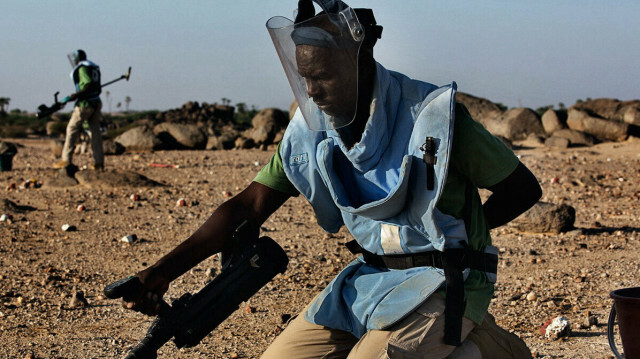
Situation still threatening, people should not ignore it, official says
South Sudan’s civil war and unrelenting floods have limited access to sites where de-mining is ongoing and have hampered the exercise, according to the Chairperson of South Sudan National Mine Action Authority, Jurkuch Barach Jurkuch.
Speaking to Anadolu Agency on the eve of International Day for Mine Awareness and Assistance in Mine Action to be celebrated on Monday, Jurkuch said removing mines planted during the war between 1983 and 2005 began in 2011 and was expected to be completed in 2021 but the civil war that began in 2013 has limited access.
“Then heavy floods which began in 2019 further added problems to the exercise, he said.
Mines and unexploded ordnances still make areas of South Sudan dangerous to travel. That affects everything from farming to aid distribution to the resettlement of residents returning home after the war and floods.
Jurkuch said in March, a military vehicle was hit by antitank mines and one person was hit by a foot mine.
“The situation is still threatening in the country and people should not ignore it,” said Jurkuch.
“We started the mine clearance in 2011 and we were told by the international community to declare South Sudan free of landmines in 2021 but we were disturbed by the civil war of 2013 and 2016 and floods affected our work because there are areas we cannot access in some part of the country.”
He said it is difficult for those who are doing mine clearance to work in areas where people are fighting and those affected by floods. And landmines and other unexploded ordnances are still a threat to South Sudanese.
“Last week a military vehicle was hit by anti-tank mines and we don’t know whether its new or the old one. The situation is still threatening and some people do ignore it. They do say those who are doing de-mining just want to get money. That statement is not true. Landmines are still there and people need to be cautious about that,” he said.
He revealed that most mine clearance is done by international organizations with prioritization and supervision of the government.
He said it is the full responsibility of the government to make sure that South Sudan is clear from landmines and other unexploded ordnances.
“My message to the people of South Sudan is that landmines are not the responsibility of South Sudan national mines action authority alone. It's the responsibility of each and every person in the country to report whenever they get a strange body or object on the ground, they must report it to the concerned authority such as we send a team to take care of it.”
The United Nations Mine Action Service (UNMAS) in South Sudan indicates that since 2004, more than 5,000 South Sudanese have been killed or injured by landmines and unexploded ordnance -- 1,398 killed, including at least 249 children and 3,718 have been injured with 717 being children.
It also added that since its inception in 2004, UNMAS has cleared 49.3 square kilometers of minefields and 78.2 square kilometers of cluster strikes and battlefields as well as surveying and confirming more than 1,169 km2 of suspected areas.
The total contamination area is now estimated to be around 17.9 square km (approximately 2,520 football pitches) with 347 remaining tasks comprised of 185 minefields, 131 cluster munitions strikes and 31 confrontation areas.
As of Feb, 25, UNMAS coordinates 20 mine action teams.
Each year the teams clear approximately 2.7 square km of minefields and 4.2 square km of cluster strikes and battlefields and deliver safety messaging to more than 300,000 people.
Hello, the comments you share on our site are a valuable resource for other users. Please respect other users and different opinions. Do not use rude, offensive, derogatory, or discriminatory language.
The floor is all yours.








